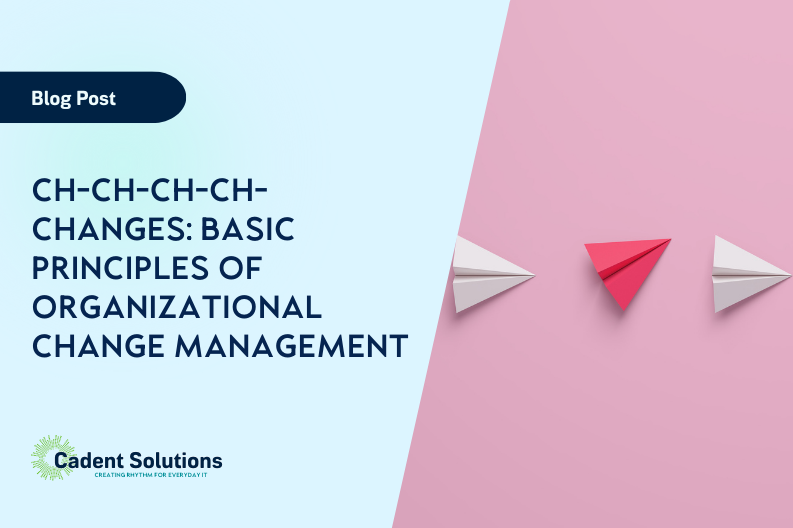Ch-ch-ch-ch-Changes: Basic Principles of Organizational Change Management
The word change is so fascinating. I think about it all the time.
For example, it’s the start of a new year, and we often start the new year off with a resolution of what we plan to change whether that be eating healthier, reading more, learning a new skill, etc. But for those changes to be successful, we must plan. We need to have a structure. And in business, it’s no different.
Change is the only constant
It’s often said that change is the only constant. This statement is very true with the rapid pace of technological advancements and today’s dynamic business environment. Companies are in a state of transformation, which means that they need to adapt quickly before the next change comes along. Changes could be simple (enhancing an existing process) or very complex (rolling out a new software release). Regardless of the complexity, companies need to have a structured approach, as without structure, the change could lead to resistance, confusion, and, ultimately, failure. This is where organizational change management comes in.
Organizational Change Management provides a framework
Organizational Change Management (OCM) is the framework for managing the impact of change on people, processes, and the organization as a whole. It ensures a smooth transition, minimizes disruption, and maximizes the likelihood of success. Some of the essentials for change management include:
1. Understanding the Need for Change:
Before embarking on any change initiative, it’s crucial to define why the change is necessary in a clear and concise manner. What is the problem to be solved and what are the opportunities to be gained? The articulation of the benefits is essential for gaining buy-in from those that the change will serve most—typically called stakeholders. This involves:
- Identifying the drivers of change: These can be things like market shifts, technological advancements, competitive pressures, and internal inefficiencies.
- Defining the desired future state: What will the organization look like after implementing the change?
- Communicating the “why” effectively: Transparent and consistent communication is key to building understanding and reducing anxiety.
2. Engaging Stakeholders:
Change impacts different people in different ways. It is crucial to identify key stakeholders — employees, customers, suppliers, etc. — and understand their perspectives. Effective stakeholder engagement involves:
- Identifying key stakeholders: Who will be affected by the change?
- Analyzing stakeholder impact: How will the change affect each stakeholder group?
- Developing a communication plan: Tailoring communication to different stakeholder groups to address their concerns.
- Actively listening to feedback: Creating channels for two-way communication to address concerns and incorporate valuable input.
3. Developing a Change Management Plan:
A well-defined plan provides a roadmap for the change process. It should outline the steps involved, timelines, responsibilities, and resources. Key elements of a change management plan include:
- Defining clear objectives and metrics: How will success be measured?
- Establishing a project timeline and milestones: When will key activities occur?
- Identifying roles and responsibilities: Who is accountable for what?
- Allocating resources: Budget, personnel, tools, etc.
- Developing a training and support plan: How will employees be equipped to adapt to the change?
4. Communicating Effectively:
Communication is the cornerstone of successful change management. It’s not just about disseminating information; it’s about building understanding, addressing concerns, and fostering a shared purpose. Effective communication involves:
- Consistent and transparent messaging: Keeping stakeholders informed throughout the process.
- Utilizing multiple communication channels: Emails, meetings, intranet, town halls, etc.
- Addressing concerns and providing support: Creating opportunities for feedback and addressing anxieties.
- Celebrating successes: Recognizing milestones and achievements to maintain momentum.
5. Reinforcing and Sustaining Change:
Change is not a one-time event—it’s a process. Reinforcement is essential to ensure the change is embedded in the organization’s culture and becomes the new normal. This involves:
- Monitoring progress and measuring results: Tracking key metrics to assess the effectiveness of the change.
- Providing ongoing support and training: Addressing any lingering issues and providing continued support.
- Recognizing and rewarding desired behaviors: Reinforcing positive changes through recognition and incentives.
- Continuously evaluating and adapting: Adjusting the change management plan as needed.
Managing change is a critical skill
Managing organizational change effectively is a critical skill in today’s rapidly evolving world. By embracing these basic principles, organizations can successfully navigate the rapids of change, minimize disruption, and achieve their desired outcomes. It’s not just about managing the change itself, but about managing the impact of that change on the stakeholders.
Contact us for a complimentary evaluation of your organizational change management procedures

